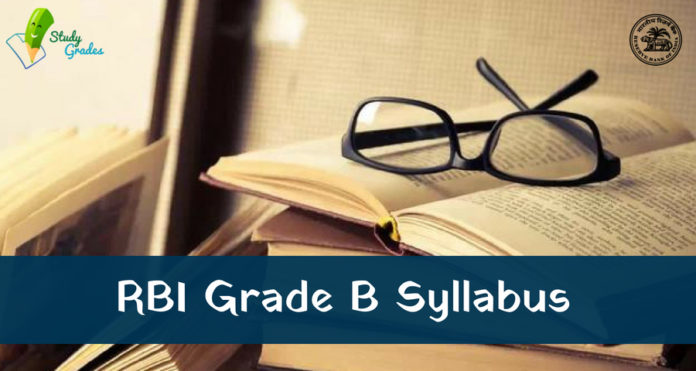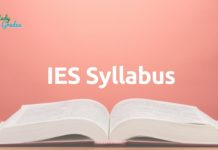RBI Grade B Syllabus 2022- RBI releases the syllabus of RBI Grade B 2022 along with official notification. RBI Grade B 2022 syllabus contains important topics and sections that candidates should prepare for the exam. Aspirants should be aware of the complete RBI Grade B 2022 syllabus and RBI Grade B pattern to prepare for the examination. Complete revised RBI Grade B exam syllabus is provided here, for the ease of the candidates.
Reserve Bank of India (RBI) will conduct the RBI Grades B 2022 Exam for recruitment of eligible candidates to the post of Officer in Grade-B. Read the article to get the complete details of the RBI Grade B Officer syllabus 2022 for Phase-1 & Phase-2 Exam, here.
Also check- RBI Grade B 2022 application form
RBI Grade B Syllabus 2022 for Phase 1
The Phase 1 comprises four different sections. Check the RBI Grade B phase 1 syllabus 2022 here
| Quantitative Ability | Reasoning | English Language | General Awareness |
| Simplification | Logical Reasoning | Reading Comprehension | Current Affairs |
| Profit & Loss | Alphanumeric Series | Cloze Test | Indian Financial Systems |
| Mixtures &Alligations | Ranking/Direction/Alphabet Test | Para jumbles | Indian Banking Systems |
| Simple Interest & Compound Interest & Surds & Indices | Data Sufficiency | Miscellaneous | Monetary Plans |
| Work & Time | Coded Inequalities | Fill in the blanks | National Institutions |
| Time & Distance | Seating Arrangement | Multiple Meaning /Error Spotting | Banking Terms |
| Mensuration – Cylinder, Cone, Sphere | Puzzle | Paragraph Completion | |
| Data Interpretation | Tabulation | ||
| Ratio & Proportion, Percentage | Syllogism | ||
| Number Systems | Blood Relations | ||
| Sequence & Series | Input Output | ||
| Permutation, Combination &Probability | Coding Decoding |
RBI Grade B Syllabus 2022 for Economic and Social Issues
- Growth and Development
- Economic Reforms in India
- Globalization
- International Economic Institutions
- IMF and World Bank
- Social Structure in India
- Gender Issues
- Social Movements
- Indian Political System
- Social Sectors in India, Health and Education.
RBI Grade B 2022 Study Material
Books:
- Indian Economy: Uma Kapila.(Series of Books)
- Indian Economy: Mishra Puri. (Latest Edition)
- Growth And Development: Devraj Ray
- Sociology: C.N. Shankar Rao
News Papers:
- Economic Times
- Hindu
- Business Standard
Weekly/Monthly Magazines/Bulletins /Reports:
- Economic and Political Weekly
- Southern Economist
- Yojana
- Business India
- RBI Bulletins
Reports:
- World Development Report
- Economic Survey of India
RBI Grade B Syllabus 2022 for Finance
(a) Financial System
- Regulators of Banks and Financial Institutions
- Reserve Bank of India- functions and conduct of monetary policy, Banking System in India, Financial Institutions – SIDBI, EXIM, NABARD, NHB, etc.
(b) Financial Markets- Primary and Secondary Markets (Forex, Money, Bond, Equity, etc.), functions, instruments, recent developments.
(c) General Topics
- Risk Management in Banking Sector
- Basics of Derivatives: Forward, Futures and Swap
- Changing Landscape of Banking sector
- Recent Developments in the Financial Sector
- Financial Inclusion
- Alternate source of finance
- Corporate Governance in Banking Sector
- The Union Budget
- Inflation
RBI Grade B 2022 Study Material
- An introduction to Economics – A W Stonier and D C Hauge
- Monetary Theory and Public Policy – Kenneth Kurihara
- Indian Economy – Mishra and Puri
- Indian Economy – R. Dutt and KPM Sundaram
- Economic Growth and Development – Mayer and Baldwin
- Major economic newspapers and Economic and Political Weekly
- Public Finance – K K Andley and Sundaram
- Financial Management – Prasanna Chandra
RBI Grade B Syllabus 2022 for Management
- Management: its nature and scope
- Leadership
- Human Resource Development
- Motivation, Morale and Incentives
- Communication
- Corporate Governance
The questions on this section will be basic in nature.
RBI Grade B Syllabus 2022 Economics
(a) Microeconomics
- Consumers behaviour and firms; value of resources like land, labour and capital
- Markets-monopoly, perfect and imperfect competition
- General Equilibrium of price and activity, economic welfare and case for regulatory / policy interventions
(b) Macroeconomics
- Measuring national income and its components; basic macro identities and idea of macro-balance; Goods and Financial Market Equilibrium (IS-LM Framework)
- Major macro-economic school of thoughts; Classical, Keynesian and Monetarist
- Consumption and Investment demand; demand management policies and their effectiveness
- Money demand and supply; monetary and fiscal policies
(c) International Economics
- Benefit of International trade; comparative and absolute advantage; effect of International trade on resources allocation and factor price equalisation; non-conventional trade barriers, optimum currency areas and effect of customs union
- International finance and exchange rates issues in an open economy, benefits and costs of an inter-connected financial markets; evolution of international financial architecture
(d) Public Economics
- Public Goods, instruments of financing, government tax and non-tax revenue
- Direct and Indirect taxes, efficiency costs of commodity taxes, income taxation, labour supply and savings, corporate taxation and corporate behaviour
- Government expenditure policy-various components, deficit financing and its impact on the economy, government debt and crowding out of private capital
(e) India’s Economy and Development Issues
- India’s experimentations with planned development models and the outcomes, structural issues-savings and investment, demography, urbanization, productivity, etc., issues with poverty, inequality and employment
- Agriculture- policy and developments, manufacturing competitiveness; what is holding India back, role of public sector enterprises in the key economic sectors, India’s resilient service sector; trade, tourism, communication, ITES, etc.
- Financial sector regulation and reforms-banking, insurance and capital market, fiscal policy and the changing priorities of government, emergence of monetary policy and its new role
Suggested Reference Material:
- Microeconomics, Student Value Edition (8th edition) by Robert Pindyck, Daniel Rubinfeld
- Intermediate Microeconomics : A modern Approach (8th edition) by Hal R. Varian
- Macroeconomics (2011) by Rudiger Dornbusch, Stanley Fisher, Richard Starz
- Macroeconomics by N. Gregory Mankiw, (Seventh Edition),
- International Economics (2013) by Domimick Salvatore
- International Economics (2011) by Paul Krugman and Maurics Obstfeld
- International Finance and Open Economy Macroeconomics (1993) by Francisco L. Rivera- Batiz, Luis A. Rivera- Batiz
- Public Finance in Theory and Practice (1989) by Richard Abel Musgrave and Peggy B. Musgrave
- The Concise Oxford Companion to Economics in India, Edited by Kaushik Basu & Annemie Maertens
- Indian Economy since Independence (2014) edited by Uma Kapila
- Indian Economy : Performance and Policies (2015) edited by Uma Kapila
- India Development Report (2015) edited by S. Mahendra Dev
RBI Grade B Officer Syllabus 2022 for Statistics
| Chapters | Topics |
| Probability |
|
| Statistical Methods |
|
| Linear Models |
|
| Statistical Inference |
|
| Multivariate Analysis |
|
| Optimisation Techniques and Statistical Quality Control |
|
| Sample Surveys and Design of Experiments |
|
| Applied Economic Statistics |
|
| Vital Statistics |
|
| Numerical Analysis |
|
| Basic Computer Applications |
|
RBI Grade B Officer 2022 Study Material
- Atkinson, K.E. (1989): An Introduction to Numerical Analysis, Wiley.
- Bhat, B.R. (2007): Modern Probability Theory, New Age International.
- Cochran, William G. (1977): Sampling Techniques. John Wiley and Sons, New York
- Das, M.N. and N. C. Giri (1986): Design and Analysis of Experiments. Wiley Eastern Ltd.
- Draper, N.R. and H. Smith (1998): Applied Regression Analysis, John Wiley & Sons.
- Goon, A.M., M. K. Gupta and B. Dasgupta (2001): Fundamentals of Statistics. (2 Vols.), World Press, Kolkata.
- Gibbons, J.D. & S. Chakrabarti (2007): Non parametric Statistical Inference, Chapman and Hall.
- Gupta, S.C. and V. K. Kapoor (2007): Fundamentals of Mathematical Statistics, Sultan Chand and Sons.
- Gupta, S.C. and V. K. Kapoor (2008): Fundamentals of Applied Statistics, Sultan Chand and Sons.
- Hollander Myles and Douglas A. Wolfe (2006): Non Parametric Statistical method, Wiley.
- Kshirsagar, A.M. (1983): A Course in Linear Models Marcel Dekker, New York.
- Montgomery, D. C. (2008): Design and Analysis of Experiments, John Wiley and Sons.
- Montgomery, D.C., E. A. Peck and G. G. Vining(2006): Introduction to Linear Regression Analysis, John Wiley and Sons.
- Murthy, M.N. (1967): Sampling Theory and Methods. Statistical Publishing Society, Kolkata.
- Rajaraman, V. (2010): Fundamentals of Computers, Prentice-Hall India.
- Rohatgi, V. K. and A. K. Md. Ehsanes Saleh (2009): An Introduction to Probability and Statistics, John Wiley and Sons.
- Saxena, H.C. (2005): Finite Differences and Numerical Analysis, S. Chand and Co.
- Silberschatz, A., H. F. Korth and S. Sudarshan (1997): Database System Concepts, McGraw-Hill.
- Sinha, P.K. (2010): Computer Fundamentals, University Science Press.
- Sukhatme, P.V., B. V. Sukhatme, S. Sukhatme and C. Asok (1984): Sampling Theory of Surveys with Applications, Iowa State University Press, Iowa, USA.
- Swaroop, K., P. K. Gupta and M. M. Singh (1985): Operations Research, Sultan Chand and Sons.
- Taha, H.A. (1982). Operations Research: An Introduction, Macmillan Publishing Company.
Stay Connected With StudyGrades for more details of RBI Grade B Officer Syllabus 2023.!!














